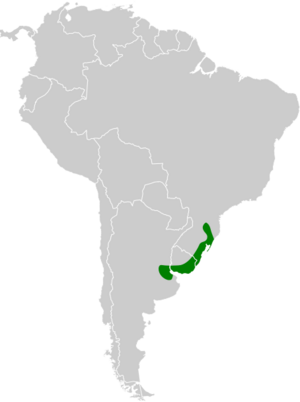Straight-billed reedhaunter facts for kids
Quick facts for kids Straight-billed reedhaunter |
|
|---|---|
 |
|
| Conservation status | |
| Scientific classification | |
| Genus: |
Limnoctites
|
| Species: |
rectirostris
|
 |
|
| Synonyms | |
|
Limnornis rectirostris |
|
The straight-billed reedhaunter (Limnoctites rectirostris) is a small bird that lives in South America. It belongs to the family called Furnariidae, which includes many birds that build interesting nests. This bird gets its name from its straight beak, which helps it find food in marshy areas.
Contents
About the Straight-billed Reedhaunter
What Kind of Bird Is It?
Scientists group animals based on how they are related. The straight-billed reedhaunter was once thought to be very close to another bird, the curve-billed reedhaunter. They both live in similar places. However, scientists now know that the straight-billed reedhaunter is actually more closely related to birds called spinetails. It is like a "sister species" to the sulphur-bearded reedhaunter. This means they are very close relatives in the bird family tree.
Reproduction and Life Cycle
We do not know a lot about how straight-billed reedhaunters have their babies. This is true for many birds in their family. In Uruguay, which is a country in South America, a young straight-billed reedhaunter was seen in the middle of January. This tells us that they likely have their young during the summer months there.
Where It Lives and What It Likes
Countries Where It Is Found
The straight-billed reedhaunter lives in three countries in South America:
Its Favorite Places to Live
This bird loves to live in marshy and swampy areas. These are wet lands with lots of tall grasses and plants. It can be found from areas near the sea level all the way up to places 1,100 meters (about 3,600 feet) above sea level.
A very important plant for this bird's home is called caraguata. These are spiny plants, like some types of Eryngium. The straight-billed reedhaunter uses these plants, especially in higher areas.
Historical Sightings
A famous scientist named Charles Darwin saw this bird way back in 1833. He found it near two lagoons in Uruguay, called Laguna José Ignacio and Laguna del Diario. Amazingly, you can still find these birds in those same places today!
Why It Needs Our Help
Threats to Its Home
Even though the straight-billed reedhaunter can be common in some places, its total numbers are going down. This is because it is losing its home, which is called habitat loss.
Some big problems for this bird include:
- Pollution: Dirty water and land can harm the plants and insects the bird relies on.
- Draining wetlands: People are drying out marshy areas to build houses or farms. This takes away the bird's home.
- Invasive plants: Some plants, like certain types of willows, eucalypt trees, and pine trees, are not native to these areas. They grow very fast and take over the natural plants that the reedhaunter needs.
How We Can Help
Good news! This bird lives in some special protected areas. One example is the Área Protegida Quebrada de los Cuervos in Uruguay. These protected areas help keep the bird's home safe from harm. By protecting these wetlands, we can help the straight-billed reedhaunter survive for many years to come.


